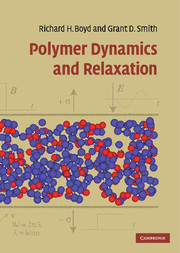Book contents
- Frontmatter
- Contents
- Preface
- Part I Methodology
- Part II Amorphous polymers
- 6 The primary transition region
- 7 Secondary (subglass) relaxations
- 8 The transition from melt to glass and its molecular basis
- Part III Complex systems
- Appendix AI The Rouse model
- Appendix AII Site models for localized relaxation
- Index
- References
7 - Secondary (subglass) relaxations
Published online by Cambridge University Press: 10 November 2009
- Frontmatter
- Contents
- Preface
- Part I Methodology
- Part II Amorphous polymers
- 6 The primary transition region
- 7 Secondary (subglass) relaxations
- 8 The transition from melt to glass and its molecular basis
- Part III Complex systems
- Appendix AI The Rouse model
- Appendix AII Site models for localized relaxation
- Index
- References
Summary
Occurrence of mechanical and dielectric secondary processes
Figure 7.1 shows torsion pendulum data for PET at temperatures much lower than the data displayed in Figure 6.16 for the glass transition region. It is evident that a significant relaxation process exists. Figure 7.2 shows dielectric loss results in PET that are complementary to the mechanical results in Figure 7.2 in terms of exploring the same relaxation region. The secondary (β) dielectric process found here has a strength that is less than that of the glass transition region but nevertheless is quite appreciable. Determination of the strength from Cole–Cole plots using dielectric permittivity data complementary to the loss data in Figure 7.2 gives a result of Δ∊(β) = 0.5. This is to be compared with the value Δ∊(α) = 2.2 from the results of Figure 6.6 for the primary transition. Comparison of the apparent width of the process with that of the glass transition process (cf. Figure 7.2 with Figure 6.5) shows the subglass process to be extraordinarily broad. That is, in the seven decades of frequency scan in Figure 7.2 only part of the subglass process is captured. In contrast in Figure 6.5 the entire glass transition region process is recorded over this frequency range. The very great breadth of secondary processes leads to small loss peak heights even though the strengths may be quite appreciable.
- Type
- Chapter
- Information
- Polymer Dynamics and Relaxation , pp. 120 - 141Publisher: Cambridge University PressPrint publication year: 2007

